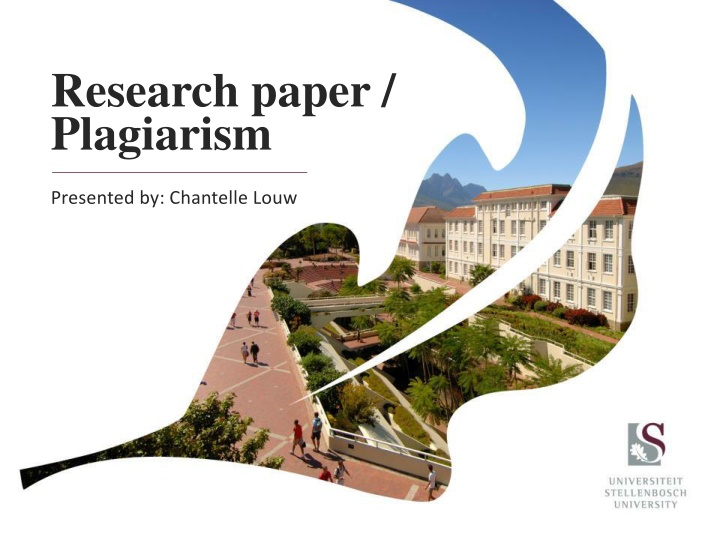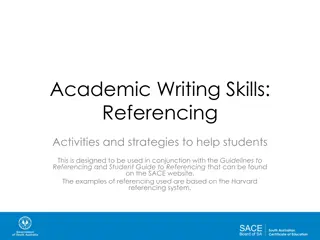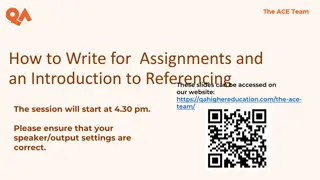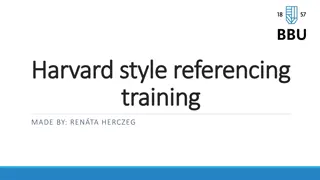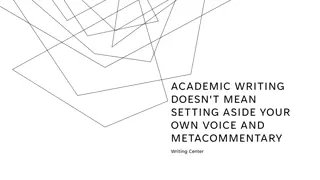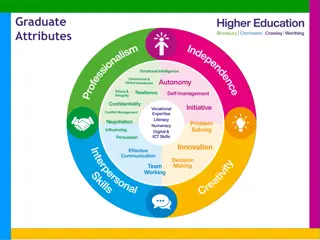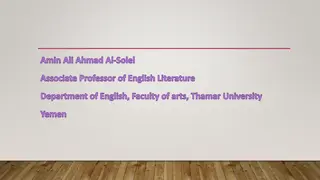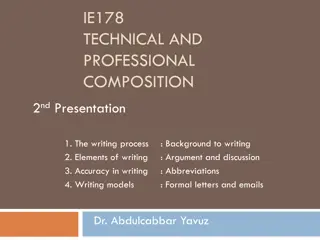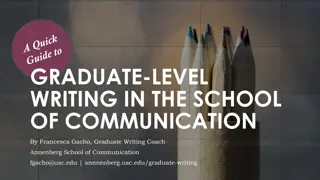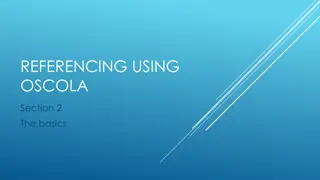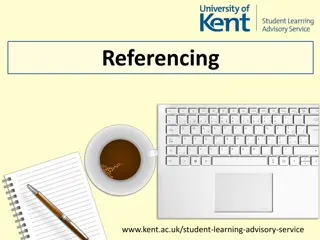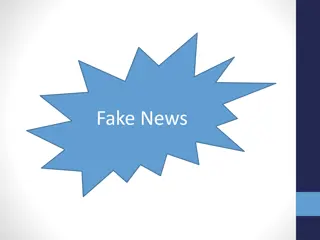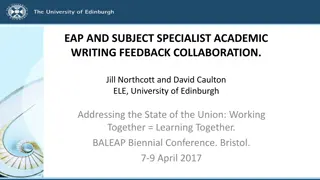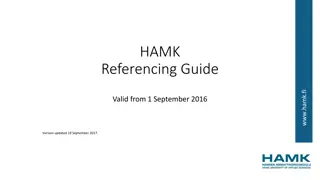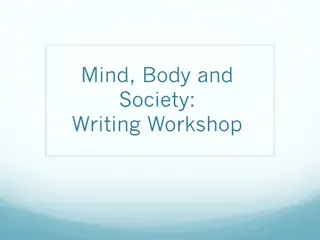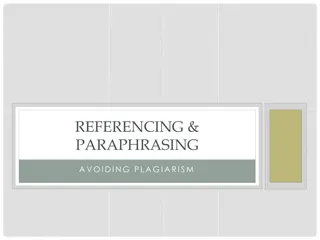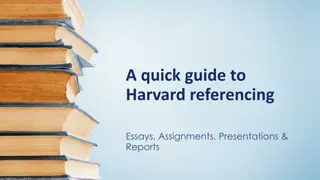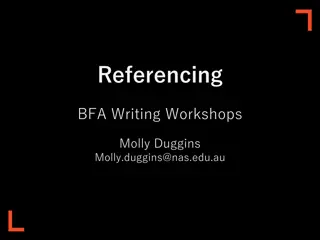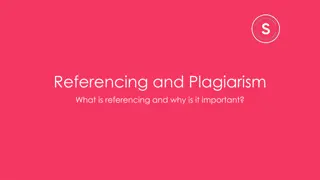Importance of Referencing in Academic Writing
Acknowledging intellectual property rights through referencing is crucial in academic writing. It allows readers to locate and learn more about the source material, supports arguments, and prevents plagiarism. Understanding the purpose of referencing is essential for ethical writing practices.
Download Presentation

Please find below an Image/Link to download the presentation.
The content on the website is provided AS IS for your information and personal use only. It may not be sold, licensed, or shared on other websites without obtaining consent from the author.If you encounter any issues during the download, it is possible that the publisher has removed the file from their server.
You are allowed to download the files provided on this website for personal or commercial use, subject to the condition that they are used lawfully. All files are the property of their respective owners.
The content on the website is provided AS IS for your information and personal use only. It may not be sold, licensed, or shared on other websites without obtaining consent from the author.
E N D
Presentation Transcript
Research paper / Plagiarism Presented by: Chantelle Louw
Technical Presentation Arial 12 1,5 line spacing Normal margins (2,54cm) 0,5 indentation each paragraph No line spaces between headings and paragraphs Footers Arial 10, single line spacing Out of text quotations Arial 11, single line spacing, 0,5 indentation whole text http://blogs.sun.ac.za/legalwriting/files/2015/02/Starter- Pack-2015.rar
Referencing What is the purpose of referencing? / Die doel van verwysings to acknowledge the intellectual property rights of others / om erkenning aan die intellektuele eiendomsreg van ander te gee; to allow the readers of your paper to locate the source material and to learn more about specific cited aspects of the paper / om die leser van jou skryfstuk in staat te stel om die bronmaterial te vind asook om meer te leer oor die spesifieke aspekte aangehaal in jou skryfstuk; to support your argument and finding(s) / om jou argument en gevolgtrekking te ondersteun.
What is plagiarism? NB! NEW PLAGIARISM POLICY http://blogs.sun.ac.za/legalwriting/writing-guide/ Defines plagiarism as: The use of the ideas or material of others without acknowledgement, or the re-use of one s own previously evaluated or published material without acknowledgement (self-plagiarism). Self-plagiarism: The re-use of one s own previously evaluated or published material without acknowledgement or indication Die gebruik van ander se idees of materiaal sonder erkenning, of die hergebruik van n persoon se eie voorheen ge valueerde werk of gepubliseerde materiaal sonder erkenning (selfplagiaat). Selfplagiaat: Die hergebruik van n persoon se eie voorheen ge valueerde of gepubliseerde materiaal sonder erkenning of bekendmaking
What is plagiarism? to pass off (the ideas or words of another) as one's own / om die woorde en idees van iemand anders as jou eie voor te doen; to use (another's production) without crediting the source / om iemand anders se werk te gebruik sonder om die bron te verwys; to present as new and original an idea or product derived from an existing source e.g. self plagiarism / om n idee afgelei van n bestaande bron as n nuwe en oorspronklike idee voor te hou bv. selfplagiaat ; In other words, plagiarism is an act of fraud. It involves both stealing someone else's work and lying about it afterward.
When should I cite? if you have taken texts verbatim from a source, quote and cite / direkte aanhalings uit n bron, gebruik aanhalings-tekens en verwys; if it is not your own ideas(s) or words e.g. paraphrased, cite / indien dit nie jou eie idee(s) of woorde is nie bv. geparafraseer, verwys; if you have translated a source, quote, cite and place [own translation] in footnote / indien jy die bron vertaal het, verwys en plaas [eie vertaling] in die voetnota; if in doubt, cite / indien jy twyfel, verwys.
Plagiarism Guidelines Download guide/ - available in Afrikaans and English. here: http://blogs.sun.ac.za/legalwriting/writing- A. Verbatim copying without quoting and referencing Excerpt from original source: may ratify a contract he or she initially concluded without the requisite assistance, with the result that the contract becomes fully enforceable with retroactive effect. When a minor reaches majority in South Africa, that is 18 years of age, he or she may ratify a contract he or she initially concluded without the requisite assistance, with the result that the contract becomes fully enforceable with retroactive effect .1 1J Heaton The South African Law of Persons 3 ed (2008) 98.
Plagiarism Guidelines B. Translated sources: Excerpt from original source: Parties must adhere to a minimum threshold of mutual respect in which the unreasonable and one-sided promotion of one s own interest at the expense of the other infringes the principle of good faith to such a degree as to outweigh the public interest in the sanctity of contracts. Translated to Afrikaans: Partye moet n minimum drumpel van wedersydse respek nakom waar die onredelike en eensydige bevordering van een party se eie belang ten koste van die ander, die beginsel van goedertrou in so n mate skend dat dit swaarder weeg as die openbare belang in die onskendbaarheid van kontrakte.2[eie vertaling] Footnote: 2R Zimmermann Good Faith and Equity in R Zimmerman & D Visser (eds) Southern Cross: Civil and Common Law in South Africa (1996) 259 259-260.
Plagiarism Guidelines C. Paraphrasing Excerpt from original source: Even if the defence of disciplinary chastisement were effectively to disappear the defence of mistaken belief that moderate corporal chastisement for educational purposes is allowed (that is, putative disciplinary chastisement), being a defence excluding fault in the form of knowledge of unlawfulness, might still be available in principle. Paraphrased: Although the defence of disciplinary chastisement might disappear, the misguided belief that reasonable physical punishment used for educational purposes is permitted, this being a defence not including liability in the form of knowledge of unlawfulness, might in principle still exist.3 NB! IF more than one sentence is paraphrased, a footnote should be placed after EACH sentence not just at the end of the paragraph. Footnote: 3JM Burchell Principles of Criminal Law 4 ed (2013) 202.
Plagiarism Guidelines D. Providing false / non-existent references This could include, inter alia, footnotes that contain false or non-existent references, for example, URL s of websites, authors, sources, page numbers, etcetera and also constitute acts of plagiarism. E. another student(s) Using a fellow student s (or students ) written assignment(s) / essay(s) / research paper(s), tutorial answer(s) or any part thereof, of any prior or current year of study, with or without the student s (or students ) consent and presenting it as your own work constitutes plagiarism. Using the written assignments / essays / research papers or tutorials answers of
How do I paraphrase effectively? Read the original until you completely understand its meaning. Now put away the original source and write your version Jot down a few words to remind you later how you envision using this material. At the top of the page, write a key word or phrase to indicate the subject Verify your version with the original source VERY IMPORTANT. Record the source (including the page).
How do I avoid committing plagiarism? Plan your assignment / research paper Take notes while conducting research and record your sources accurately Do not copy and paste any content from your research directly into your own assignment Where possible, print your sources so you can refer to it again later Read your researched sources repeatedly until you understand it Err on the side of caution rather cite Learn how to paraphrase properly Use Turnitin
Turnitin Wrong impressions about Turnitin - what it is, what it does, how it works. The #1 misconception: that Turnitin detects plagiarism. Turnitin does not detect plagiarism it merely finds and shows text that matches other sources in the Turnitin databases It is up to you to determine whether those text matches are a problem or not. It is important to realise that the Similarity Index is NOT a "plagiarism index . 5% does not necessarily mean that you have NOT committed plagiarism just as 75% does not necessarily mean that you HAVE committed plagiarism. YOU NEED TO WORK THROUGH YOUR REPORT AND ESTABLISH WHETHER YOU REFERENCING REQUIREMENTS. HAVE COMPLIED WITH THE http://turnitin.com/en_us/component/content/article?id=1643:does- turnitin-detect-plagiarism
Dankie Thank you Enkosi
